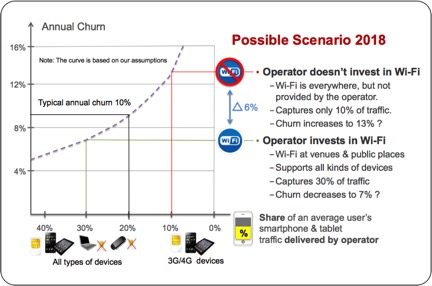Editor’s Note: With 2015 now upon us, RCR Wireless News has gathered predictions from leading industry analysts and executives on what they expect to see in the new year.
It’s been an incredible year for Wi-Fi. T-Mobile US created a watershed moment for U.S. carriers with the introduction of Wi-Fi calling, a bold move that not only forever changed the way consumers use data but – as all carriers are quickly realizing – the way in which mobile operators deliver future services and generate profits.
With Wi-Fi calling (voice over Wi-Fi) and voice over LTE, even voice has become data, going over the same IP network as the data services. This has quickly changed the business models to charge only for data used instead of voice minutes.
GSMA predicts that carriers will “lose” 85% of mobile data traffic to Wi-Fi networks by 2018. Looking at what´s happening in the U.S., that makes sense: Users want Wi-Fi for faster speeds, to avoid expensive data plans and, now, they see the opportunities to use Wi-Fi instead of cellular calls. Carriers are waking up to this trend.
What many carriers don’t yet realize is that the loss of traffic to Wi-Fi will accelerate rapidly in 2015. Wi-Fi has become a must-have insurance policy for their very survival.
Yet, this is an opportunity for them. Many carriers fear that profits will go up in smoke as users turn their backs on cellular. That’s just not the case. Why, you ask? Because even “free” Wi-Fi offers a good business opportunity for service providers, and you must have a holistic view and not look at cellular and Wi-Fi as separate things.
Next year we’ll see this fundamental shift playing itself out in the mobile industry. Some predictions are based on what we’re hearing during customer discussions and in RFPs not only from U.S. carriers but abroad as well.
The real ROI for carrier Wi-Fi
Adding some tens of millions of dollars in Wi-Fi services revenues for a mobile operator with billions in their core 3G/4G business will not make executives happy, even if the Wi-Fi champions can show a return on investment in a few years.
But churn rates will be much different for an operator that captures 10 to 15% of the mobile data traffic, which can be the future case for an operator that does not invest in Wi-Fi, compared to an operator that deploys Wi-Fi and, let’s say, captures 30 to 40% of the traffic. The more relevant you are for a customer, the higher the probability that they will stay with your service. We have seen this with many of our operator customers that have an excellent Wi-Fi service and lower churn rates than the competition.
Churn represents one of the highest costs for an operator, so if you count in the customer retention aspect in the Wi-Fi ROI, the yearly “revenue” can be counted in hundreds rather than tens of millions of dollars.
Monetizing ‘free’ venue Wi-Fi
In 2015, a huge priority will be to find ways to monetize the “free” Wi-Fi offered at different venues. Carriers are already starting to develop relationships with sports stadiums, shopping malls and other venues to offer free Wi-Fi in exchange for user information: information that’s incredibly valuable to local marketers. In 2015, this will accelerate rapidly.
Wi-Fi calling
Yes, every 2015 prediction will talk about the expansion of Wi-Fi calling. In the U.S., T-Mobile US has a head start, but most operators that already have deployed an IP multimedia subsystem in their infrastructure for supporting VoLTE will plan for and start to introduce Wi-Fi calling during 2015.
Remember, Wi-Fi calling isn’t a new application. Today we’re seeing the dawn of next-generation Wi-Fi calling where support for VoWi-Fi is embedded directly into the dialer of the device, in the same way as for VoLTE, which allows calls to be made through any Wi-Fi connection with access to the Internet.
VoLTE continues to take off
While Wi-Fi is grabbing most of the attention, other technologies will also be important in 2015. Operators, especially in developed countries, are moving quickly toward a full IMS and VoLTE infrastructure.
There are a number of reasons why operators want to move away from traditional 2G/3G circuit-switched networks toward all IP-based VoLTE. LTE is more spectrum-efficient than 2G/3G. Additionally, operators can start to refarm valuable spectrum from existing 2G/3G networks for future LTE and upcoming “5G” services.
Reaping intelligence from the network
Every mobile network technology is starting to gather data about user activity, creating a whole new level of network intelligence, through:
• Social media – Using social media as a platform for login to different, often free, external services including Wi-Fi has becoming increasingly popular. It is exceptionally easy for users to have a single sign-on experience. But, when social media asks you to share your public profile, remember that there is no such thing as a free lunch. Or, as Apple CEO Tim Cook recently put it: if you are using a free service then you are not a customer. You are the product. The service provider will for sure use your personal information.
• Location-based information – Wi-Fi access points can pick up where users are, where they (for example) shop in a mall and how much time they spend at a certain store. Imagine knowing that users congregate at the front of the store during a certain time period can inform what items are popular and what are not. Combining this with data from social media provides valuable demographic and behavior information.
Location-based information can also be used, for example, to push coupons to users as they reach a specific store. Or, in a sports arena, push branding for a specific brand of soda as users head to the food counter. Or push information as to where to find the nearest exit. Or to provide fun games, game stats, etc. The opportunities are endless.
All this gathering of information is also a benefit to the user. If I must “endure” an advertisement in return for free Wi-Fi it might just as well be an ad that is tailored to who I am and to my present location.
Paul Mikkelsen has more than 20 years of experience in international telecommunication and IT and was part of Aptilo Networks’ founding team in 2001. Prior to Aptilo he was director of business development at Axis, responsible for the European market for the mobile Internet division. Mikkelsen held different executive positions in marketing and business during 10+ years at Ericsson. While there, based in Kuala Lumpur, he was responsible for fixed public operator business for the region. Paul holds a Bachelor of Business Administration and Economics from the University of Örebro, Sweden.



